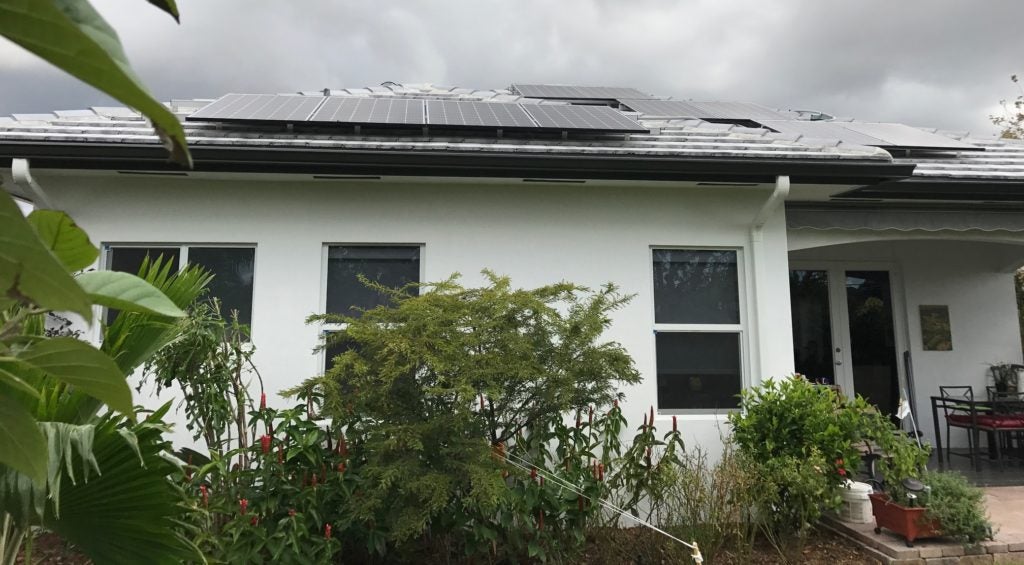Make your solar system resilient with solar plus storage

Increasingly violent weather events are changing the conversation about the system that delivers our electricity. Going solar can empower homeowners to take resilience into their own hands. Rooftop solar systems have a good track record of withstanding the worst that Mother Nature can throw at them.
In September of last year, Hurricane Florence caused extensive damage in the Carolinas. According to this article, there were massive outages in North Carolina, at one point depriving 300,000 residents of power. However, most of these incidents involved fossil-fuel-produced electricity. By contrast, the status of renewable energy in the aftermath of the big storm in North Carolina – the second-largest state in solar capacity after California, at 4.6 percent – remained fairly stable. Of rooftop solar provider Yes Solar Solutions’ customers, only 6 out of 800 reported a problem.
In the previous month, Hurricane Lane hit Hawaii hard. The director of the Hawaii Solar Energy Association even sent out an email to members with guidance on how to deal with solar customers’ inquiries in the aftermath of the disaster. However, he never heard from either solar installers or developers about any problems, and utility HECO confirmed that there were no reports of damage to solar systems.
Solar is better able to withstand natural catastrophes than traditional generation and storage methods because fossil-fuel powered generators rely upon supply lines to function. Panels powered by sunlight do not. Grid-tied solar homes without storage won’t work if the power is out after a major storm, because those solar homes automatically shut down if the grid goes down, to protect linemen. However, those homes that also have solar battery storage would probably have enough stored energy to power the home during a blackout, and they can recharge each day after that, without their owners worrying about where to get fuel to charge the systems.
John Weaver, a writer for the blog CommercialSolarGuy.com, who wrote an article for pv magazine on the topic of solar panels and natural disasters, believes that such outcomes tend to increase interest in renewables generally, to the point that resilience may become a strong selling point for rooftop solar. Those forced to get by without electric power in an emergency may come to see the advantages of solar in more than monetary terms.
“The emotional burn of days and weeks without AC, hot water, and perishable goods is worth a million bucks,” Weaver said.
Certainly, one effect of increasingly frequent and intense storms due to climate change is to make the issue of energy resilience a hot one, though interest seems to flag somewhat between clusters of natural disasters. While acknowledging this fact, Weaver believes that the “thin, simple power line system” might pose “a much greater risk” to resilience than previously imagined.
Solar + storage = resiliency
Hurricane Maria highlighted the issue of storage. “Most of the more than 10,362 renewable energy units installed by Puerto Ricans ended up as roof ornaments,” according to this report by the Puerto Rico-based organization CPI (in English: Center for Investigative Journalism). The majority of systems were grid-tied. When the grid shut down after the hurricane, the system automatically shut off all connected solar to protect workers repairing power lines from possible shocks. Only those with their own storage systems continued to generate electricity.
“If your system cannot run when the grid goes down, then you are not resilient,” Weaver said. “A non-storage [solar] system is an economic and environmental investment, not a resilient investment.”
Weaver believes it is possible to come up with a dollar value for resilience, citing an article he wrote about the Energy Storage Association (ESA), which uses the terminology “Value of Lost Load.”
“One way of attempting to price these challenges is via considering the Value of Lost Load (VOLL). The [ESA] report suggests that between 2017 and 2025, the United States will see a cumulative [VOLL] loss of $295 billion! Installing 35 GW of energy storage is estimated at $48.7 billion in costs. If this energy storage volume increases our reliability [only] 10%, then we’ll save $29 billion, almost 60% of the cost of this hardware.”
Pointing out that the average American in 2017 experienced eight minutes of energy downtime, Weaver said that, for residential customers, the resilience offered by solar plus storage “is a much more emotional sale – a sale of a convenient life.”
